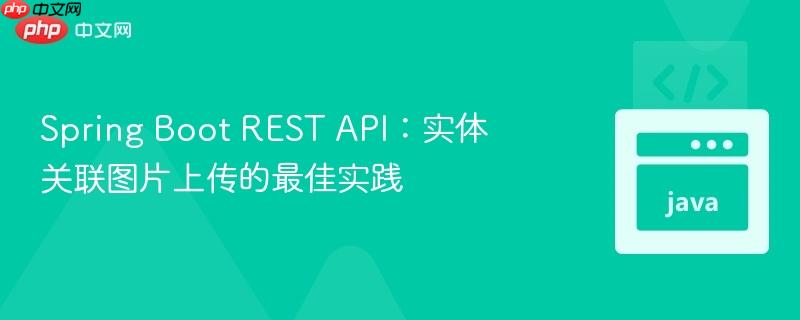
在 Spring Boot REST API 应用中,如何优雅地将图片上传并与实体关联?我们将分析一种常见的做法,即同时接收实体和图片,并提出一种更佳的方案,通过拆分 API 职责,实现前后端分离,提高代码的可维护性和可扩展性。核心在于将实体创建和图片上传分离成两个独立的 API 接口,从而避免参数冲突,并使前端开发更加灵活。
假设我们有一个 Event 实体,包含 name、description 等字段,现在需要添加一个 photo 字段,用于存储图片引用。一种常见的做法是在创建 Event 的 API 接口中,同时接收 Event 对象和图片文件:
@PostMapping("/events")
public ResponseEntity<Event> createEvent(@RequestBody Event event,
@RequestParam("image") MultipartFile multipartFile) throws IOException {
// ...
event.setPhoto(StringUtils.cleanPath(multipartFile.getOriginalFilename()));
// save event in repo
// upload image to directory event-photos/{eventId}
// return event with photo field
}这种做法看似简单,但存在一些问题:
更好的方案:分离 API 职责
更推荐的做法是将实体创建和图片上传分离成两个独立的 API 接口:
@PostMapping("/events")
public ResponseEntity<Event> createEvent(@RequestBody Event event) {
Event savedEvent = eventRepository.save(event);
return ResponseEntity.ok(savedEvent);
}@PostMapping("/events/{eventId}/upload")
public ResponseEntity<String> uploadImage(@PathVariable Long eventId,
@RequestParam("image") MultipartFile multipartFile) throws IOException {
Event event = eventRepository.findById(eventId)
.orElseThrow(() -> new ResourceNotFoundException("Event not found with id " + eventId));
String fileName = StringUtils.cleanPath(multipartFile.getOriginalFilename());
// 保存图片到指定目录,例如 event-photos/{eventId}
String uploadDir = "event-photos/" + eventId;
FileUploadUtil.saveFile(uploadDir, fileName, multipartFile);
event.setPhoto(fileName);
eventRepository.save(event);
return ResponseEntity.ok("Image uploaded successfully: " + fileName);
}代码示例:FileUploadUtil 类 (示例)
import java.io.IOException;
import java.io.InputStream;
import java.nio.file.Files;
import java.nio.file.Path;
import java.nio.file.Paths;
import java.nio.file.StandardCopyOption;
import org.springframework.web.multipart.MultipartFile;
public class FileUploadUtil {
public static void saveFile(String uploadDir, String fileName,
MultipartFile multipartFile) throws IOException {
Path uploadPath = Paths.get(uploadDir);
if (!Files.exists(uploadPath)) {
Files.createDirectories(uploadPath);
}
try (InputStream inputStream = multipartFile.getInputStream()) {
Path filePath = uploadPath.resolve(fileName);
Files.copy(inputStream, filePath, StandardCopyOption.REPLACE_EXISTING);
} catch (IOException ioe) {
throw new IOException("Could not save image file: " + fileName, ioe);
}
}
}优点:
注意事项:
总结:
将实体创建和图片上传分离成两个独立的 API 接口是更佳的实践方案。这种做法可以提高代码的可维护性和可扩展性,使前后端开发更加灵活。在实际项目中,应根据具体需求选择合适的方案。 记住,清晰的API设计是良好架构的基础。
以上就是Spring Boot REST API:实体关联图片上传的最佳实践的详细内容,更多请关注php中文网其它相关文章!

每个人都需要一台速度更快、更稳定的 PC。随着时间的推移,垃圾文件、旧注册表数据和不必要的后台进程会占用资源并降低性能。幸运的是,许多工具可以让 Windows 保持平稳运行。

Copyright 2014-2025 https://www.php.cn/ All Rights Reserved | php.cn | 湘ICP备2023035733号